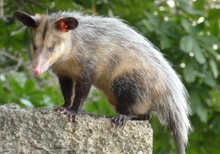
Opossum - Equine protozoal myeloencephalitis
Regardless of the cause of a neurological disorder, diagnostic evaluation of central nervous system disorders in horses begins with a neurological examination providing anatomic localization of the problem.
© 2018 by Wikipedia - Wolfman
Stephen M . Reed, DVM, Dip ACVIM of Rood and Riddle Equine Hospital in Lexington, KY in an article Diagnostic Approach to Equine Neurological Diseases posted in the January 2018 edition of the Equine Disease Quarterly of the University of Kentucky delineates important information related to these four central nervous system disorders in horses.
Regardless of the cause, diagnostic evaluation of suspected central nervous system disorders in horses begins with a neurological examination, which provides anatomic localization of the problem within the central nervous system. Then the diagnostic investigation continues with more focused testing.
Cervical vertebral stenotic myelopathy (CSM)
If cervical vertebral stenotic myelopathy is strongly suspected, radiographs of the neck should be taken. Narrowing of the cervical vertebral canal in combination with malformation of the cervical vertebrae results in compression of the spinal cord in CSM patients. Standing lateral radiographs of the cervical vertebrae often reveal bony malformations and probable narrowing of the vertebral canal.
Myelography is an important antemortem diagnostic tool and is essential prior to surgical intervention. CSM occurs primarily in young horses (3 months to 1 year of age) where it is a multifactorial disease. In older horses, CSM is often secondary to osteoarthritis of vertebral articular process joints.
Equine protozoal myeloencephalitis (EPM)
The neurologic exam for suspect EPM horses shows asymmetric ataxia, often with upper and lower motor neuron signs and muscle atrophy. Sarcocystis neurona is the most common cause of EPM, but Neospora hughesi infection can also cause similar clinical signs.
Several studies of S. neurona demonstrate that horses residing in states with opossums have an exposure rate of 33% to 53%. The exposure rate for N. hughesi appears to be much lower, although less epidemiologic data is available for this organism.
Risk factors for S. neurona infection include age (< 5 and >13 years), time of year (summer and spring more than winter), whether previous cases had been recognized on the farm, presence of a wooded area, and presence of opossums on the farm.
Prevalence of the disease was reduced on farms where wildlife had little or no access to feed and if a creek or river was on the premises. Diagnosis of EPM remains a challenge and should begin with physical and neurological examinations. This is followed by measurement of antibodies against the causative organisms in blood and CSF. Unfortunately, the only definitive test for EPM is a postmortem examination.
Degenerative myeloencephalopathy (EDM)
The third common cause of spinal ataxia in horses is equine degenerative myeloencephalopa- thy (EDM). This condition has been recognized in several breeds and has a familial predisposition.
EDM is caused by oxidative damage to propriocep- tive relay tracts, thus measurement of vitamin E has been used as a marker for this condition. More recently a genetic marker has been associated with the disease and genetic testing has proved valuable.
Equine herpesvirus 1 myeloencephalopathy (EHM)
Equine herpesvirus 1 myeloencephalopathy (EHM) is an infrequent but serious outcome of equine herpesvirus 1 infection. Although the virus has been recognized for a long time, a link to neurological disease was only made in the past fifty years.
More recently, a point mutation in the virus has been identified that allows it to replicate rapidly and results in a higher frequency of neurologic disease. Damage to the nervous system develops near infected blood vessels, which results in “stroke-like” episodes.
The disease usually follows an initial phase of viral replication in the respiratory tract and peripheral blood mononuclear cells. Viral replication also occurs in respiratory epithelium, gonadal cells, and tissues of the gestating fetus. Infection can result in fever, respiratory disease, weak foals, abortion, and neurological disease.
Neurologic signs often include ascending paralysis with urine dribbling, loss of anal tone and control, poor tail tone, and pelvic limb weakness.Diagnosis of EHM is easier to establish when several horses on the same premises present with fever, followed by ataxia and urine dribbling and in some cases abortion.
When spinal fluid is collected it often appears xanthochromic as a result of the vascular damage leading to increased protein but no increase in cell count. Beyond this, diagnosis can be established by recognition of clinical signs and positive EHV-1 PCR results of a nasal swab and buffy coat. Confirmation of the disease is by virus isolation in cell culture.
Recognition of specific clinical signs, anatomic localization of lesions, and utilization of diagnostic tests can help differentiate the common neurologic diseases.
